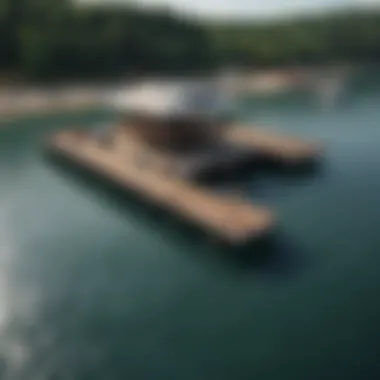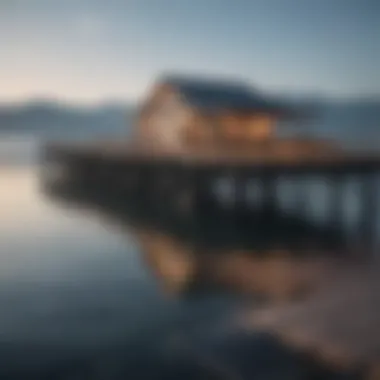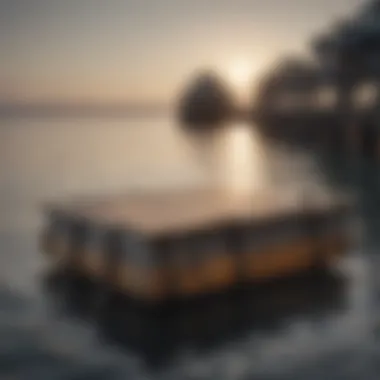Constructing a Floating Pier: A Comprehensive Guide


Intro
Constructing a floating pier involves a multitude of factors that require careful consideration. This guide serves to illuminate the complexity of the process involved in creating a floating structure that can withstand environmental forces while providing functionality. Floating piers offer versatility, serving numerous purposes from recreational activities to commercial ventures. They can be an asset for boat enthusiasts, enhancing boating experiences and facilitating better access to waterfronts. Understanding the intricacies of design, material selection, construction techniques, and maintenance can significantly impact the project's success.
In this article, we will cover essential topics, including current trends, environmental considerations, and regulatory requirements. Whether you are an enthusiast or a professional, this comprehensive guide aims to assist you in navigating the world of floating piers with clarity.
Current Trends
Overview of Floating Pier Market
The floating pier market has seen growth due to the increasing interest in water-based recreational activities. More people are venturing into boating and water sports, thus elevating the demand for well-constructed floating piers. Innovations in design and construction techniques have also contributed to this upward trend. The market now features modular floating systems that simplify installation and minimize ecological footprints. These advancements address environmental concerns while ensuring user convenience.
Key Drivers Influencing Construction
The popularity of floating piers is driven by several factors:
- Innovation in Materials: Lightweight and durable materials like polyethylene and concrete are now widely utilized, enhancing structural effectiveness.
- Sustainability: An increasing focus on eco-friendly designs is pushing manufacturers towards sustainable practices.
- Urban Planning: As urban areas expand, the demand for recreational bodies of water is prompting new installations.
- Regulatory Support: New regulations promoting waterfront development are enabling easier permits for floating pier construction.
Floating piers are becoming more accessible due to these trends, making it paramount for enthusiasts and professionals to stay informed about the evolving market and its influences.
"The future of floating piers relies not only on aesthetics and functionality but also on the adoption of sustainable practices that prioritize environmental health."
Foreword to Floating Piers
Floating piers offer a unique solution for various marine applications. They hold particular significance in areas where traditional piers may face limitations due to water fluctuations, environmental concerns, or navigational demands. Understanding the foundation of floating piers is essential to grasp the advantages they provide, as well as the considerations that come into play during their construction and use.
The rise in the popularity of floating piers stems from their versatility. Unlike fixed structures, they adapt to changing water levels, providing stable access to boats and waterfronts without the complications of as fixed marine structures. This adaptability is particularly useful in regions with significant tidal ranges or fluctuating water levels, making them a preferred choice for recreational boating, fishing, and even residential purposes.
Key Benefits of Floating Piers:
- Environmental Integration: Floating piers minimize the disruption to local ecosystems. Their design often allows for the natural movement of water and wildlife beneath them, preserving aquatic habitats.
- Cost-Effectiveness: In some cases, floating piers can be less expensive to construct than traditional piers. The need for extensive foundational work is often reduced.
- Ease of Maintenance: Due to their construction, maintenance can be simpler compared to fixed piers, as access is less obstructed by water.
Despite their advantages, constructing a floating pier involves considerations that must be carefully evaluated. Site selection plays a pivotal role. Areas with heavy currents, for instance, may require more robust designs. Additionally, environmental assessments and local regulations must be adhered to in order to ensure sustainable practices are observed during construction.
This section serves as the starting point for a comprehensive exploration of floating piers. It emphasizes the critical elements, benefits, and considerations essential for understanding the role floating piers play in modern marine architecture. By delving deeper into the subsequent sections of this guide, readers will gain insight into effective practices for constructing a floating pier, paving the way for innovative waterfront solutions.
Understanding Floating Pier Concepts
Floating piers have gained prominence in marine architecture for various benefits they offer. Understanding their fundamental concepts is vital for both aspiring builders and users to grasp how they function and the advantages they present. This section delves into the definition, comparative analysis, and benefits of employing floating piers in different settings. An informed approach establishes a strong foundation for the successful construction and application of these structures.
Definition of Floating Piers
A floating pier is defined as a structure that remains buoyant by utilizing the displaced water's force to support itself. Unlike traditional piers, which are anchored to the seabed, floating piers rest on the water's surface, adjusting to fluctuations in water levels. They typically consist of a series of flotation devices, such as floats or pontoons, coupled with a walking platform made of wood, concrete, or composite materials. The adaptability of floating piers makes them particularly suitable for locations with shifting tides, seasonal water level changes, or areas susceptible to extreme weather conditions.
Comparison with Traditional Piers
Floating piers differ significantly from traditional piers in various aspects:
- Structural Stability: Traditional piers require deep foundations and permanent anchoring to withstand environmental forces. Floating piers, on the other hand, inherently remain stable as they adjust to water movements.
- Construction Time and Cost: Building a traditional pier can involve extensive groundwork, increasing both time and cost. Floating piers can often be installed more quickly, making them a more economical choice for temporary or seasonal projects.
- Environmental Impact: Traditional piers may disrupt aquatic ecosystems due to their anchoring methods. Floating piers minimize disruption, allowing for greater ecological preservation in sensitive marine environments.
Advantages of Floating Piers
The advantages of floating piers are numerous and noteworthy:
- Versatility: These piers can be deployed in a variety of settings, including lakes, rivers, and coastal environments. They adapt easily to changing water levels.
- Ease of Maintenance: Maintenance requirements can be lower than that of traditional piers because floating structures are less prone to damage from corrosion or sediment buildup.
- Portability: Floating piers can be disassembled and relocated, making them an appealing option for events or temporary access needs.
- Cost-Efficiency: While initial material costs may vary, the reduced need for extensive foundation work may lead to overall lower construction expenses.
"Floating piers offer both flexibility and stability, making them an efficient choice for various marine applications."


In summary, understanding floating piers helps stakeholders and builders appreciate their application, feasibility, and advantages in both environmental and economic contexts.
Key Considerations Before Construction
Before embarking on the construction of a floating pier, several critical considerations must be taken into account. These factors directly influence the overall success and sustainability of the project. Understanding the right strategies in site selection, environmental impact, and regulatory requirements will lay the foundation for a well-executed installation. These elements act as guiding principles that ensure safe, effective, and compliant floating pier construction.
Site Selection and Survey
Choosing the right location for the floating pier is paramount. Factors such as water depth, currents, and accessibility to land must be carefully evaluated. Conducting a thorough survey can reveal vital information about the existing conditions.
- Water Depth: Verify that the depth is suitable for the intended use. Floating piers need sufficient space to avoid obstruction during low tide.
- Currents: Understanding the water currents helps in designing a pier that can withstand potential shifting or unwanted movement.
- Accessibility: The pier should be easily reachable from the shoreline for materials and users, which can impact the construction process and ongoing operations.
A comprehensive site survey can help in identifying potential issues before construction begins. This may involve using sonar technology or underwater cameras to gather detailed data about the lake or ocean floor.
Environmental Impact Assessments
Conducting an environmental impact assessment (EIA) is essential for ensuring that the floating pier construction does not harm the surrounding ecosystem. Potential impacts on local wildlife, vegetation, and water quality must be examined.
- Wildlife Considerations: Identify if the area serves as a habitat for endangered species or significant fish populations.
- Water Quality: Evaluate the potential for pollutants to leach into the water, affecting both marine life and recreational uses.
- Erosion and Sedimentation: Analyze if construction could alter natural flow patterns, leading to erosion or sedimentation issues.
Incorporating eco-friendly practices not only serves legal obligations but also enhances the project’s reputation amongst environmentally conscious stakeholders. Engaging with local environmental groups can provide insights into best practices and community expectations.
Understanding Local Regulations
Navigating the regulatory landscape is crucial for floating pier construction. Every region has specific laws governing shoreline development, which can vary significantly.
- Permits: It is vital to secure all necessary permits before starting construction. These might include environmental permits, zoning approvals, and construction permits.
- Local Guidelines: Research local guidelines related to construction activities, materials used, and environmental protection measures. Compliance with these rules reduces the risk of costly fines or project halts.
- Community Impact: Consulting with local authorities and stakeholders will provide clarity on any community-sensitive issues and help foster better relationships moving forward.
In summary, paying attention to key considerations like site selection, environmental impacts, and local regulations is fundamental. This careful approach will lay the groundwork for a successful and responsible floating pier construction process.
"Proper planning and thorough evaluations protect not only the integrity of the project but also the environment that surrounds it."
Regularly revisiting these key points throughout the construction phase ensures continued adherence to best practices, ultimately leading to a successful floating pier that serves its intended purpose.
Designing Your Floating Pier
Designing a floating pier is crucial in the overall construction process. This phase ensures that the pier will be functional, durable, and safe. A well-thought-out design can prevent potential issues that may arise during and after construction. Effective design takes into account environmental conditions, user requirements, and specific functionalities. Additionally, it addresses material selection and load distribution, which are essential for stability and safety.
Taking the time to properly design your floating pier ultimately enhances its usability and longevity.
Basic Design Elements
The basic design elements of a floating pier include several fundamental aspects. These involve:
- Dimensions: The size of the pier must suit its intended use. Factors include expected traffic, type of vessels, and local regulations.
- Buoyancy: Selecting an appropriate buoyancy type can determine the stability of the pier. Common choices are pontoons made from concrete or polyethylene.
- Wave Resilience: Designing for wave conditions is critical. This can involve adjusting the pier's shape or height to reduce wave impact.
- Access Points: Location and design of access points are vital for safety and convenience.
Properly incorporating these elements is essential in ensuring the floating pier performs well in various conditions.
Load-Bearing Requirements
Load-bearing requirements are essential to ensure that the pier can safely support the maximum weight it will encounter. This includes considerations for:
- Vessels: Boats or other watercraft will have specific weight limits. The design should accommodate these without compromising stability.
- Personnel: If the pier is used by people, it must accommodate foot traffic and any additional equipment.
- Environmental Forces: Factors such as wind, current, and wave action can contribute to loads acting on the pier. Evaluating these forces helps in the design process.
Using engineering calculations can assist in determining these requirements, ensuring that safety is prioritized without sacrificing functionality.
Safety Considerations
Safety is a fundamental aspect of floating pier design. Key safety considerations include:


- Material Quality: Using high-quality, weather-resistant materials can prevent erosion and failure over time.
- Structural Integrity: Regular assessments of structural elements, especially joints and connectors, can identify weaknesses.
- Emergency Access: Design should allow quick access for emergency services, enhancing safety for users.
- Guardrails and Lighting: Implementing guardrails and adequate lighting can minimize accidents, especially in low-visibility conditions.
Attention to these factors in the design phase will create a safer environment for users, ensuring that the floating pier fulfills its intended purpose effectively.
"A well-designed floating pier not only enhances functionality but also significantly improves safety for all users."
By dedicating proper focus on designing elements, load-bearing requirements, and safety measures, a floating pier can serve as a reliable asset for both recreational and commercial uses.
Choosing the Right Materials
Choosing the right materials is crucial when constructing a floating pier. The materials you select not only impact the pier's performance but also its longevity and maintenance needs. Selecting appropriate materials involves understanding their properties, how they can withstand environmental conditions, and their overall sustainability. These choices ultimately affect the project's functionality, aesthetics, and cost.
Common Materials for Floating Piers
Floating piers can be constructed with a variety of materials, each offering distinct advantages. Commonly used materials include:
- Wood: Traditional and aesthetically pleasing. It is important that the wood be treated to prevent rot and damage from marine organisms.
- Concrete: Known for durability and low maintenance, concrete is heavy. It provides stability but may require additional buoyancy solutions.
- Plastic: Lightweight and resistant to water damage, plastic materials, such as HDPE (High-Density Polyethylene), are easy to handle and do not corrode.
- Aluminum: This material is robust and corrosion-resistant. Aluminum floating piers are light and easy to install but can be more expensive than other options.
Each option has different applications and benefits, so understanding the specific needs of your project will help in selecting the appropriate material.
Durability and Maintenance Aspects
Durability is a key consideration. Every material reacts differently to environmental factors such as UV exposure, saltwater, and biological growth.
- Wood generally needs regular maintenance, including sealing and painting, to extend its life. Even treated wood can require periodic checks to assess its integrity.
- Concrete is robust but can suffer from cracking due to thermal changes or water infiltration. It may require sealing to prevent moisture-related damage.
- Plastic and aluminum typically require less maintenance. However, they can develop surface wear over time, especially under heavy use.
Selecting a durable material reduces long-term costs and ensures safety and functionality.
Material Cost Considerations
Cost is another significant factor when choosing materials. It is not just about initial purchase price. Total lifespan costs should also be evaluated.
- Wood can be less expensive upfront, but maintenance and replacement costs could increase over time.
- Concrete has a higher initial cost but offers long-term savings and lower maintenance needs.
- Plastic is relatively affordable, but prices can fluctuate based on market demand and availability.
- Aluminum may be the costliest option initially, but its durability can lead to savings by reducing replacement and repair cycles.
Evaluating the total cost of ownership is essential. Factor in installation, maintenance, and expected lifespan when making your decision.
Construction Techniques
Understanding the construction techniques for a floating pier is crucial for the overall success and longevity of the project. These techniques lay the groundwork and provide the necessary stability for the floating structure. Using the right methods not only ensures safety but also enhances durability and functionality. Key elements include foundation and buoyancy concepts, a step-by-step construction process, and the use of standardized kits.
Foundation and Buoyancy Concepts
The foundation and buoyancy of a floating pier are fundamental concepts that dictate its performance. A sound foundation ensures that the structure can withstand environmental forces while maintaining stability. Buoyancy is essential in allowing the pier to float on water.
To achieve adequate buoyancy, it's important to:
- Utilize materials that are lightweight yet strong. Common choices include high-density polyethylene or reinforced concrete.
- Ensure proper distribution of weight to balance the structure effectively.
Regarding foundations, anchored systems provide resistance against wave action. Therefore, understanding water levels, current flow, and potential wave heights near the location is vital. Evaluating these factors contributes to a successful floating design.
Step-by-Step Construction Process
Following a structured construction process is key. Each phase should be carefully executed. Here’s an outline:
- Planning Phase: Establish the design specifications and obtain necessary permits. 1.1 Conduct site surveys and environmental assessments.
- Material Preparation: Gather all necessary materials, including floats, connecting hardware, and anchoring systems.
- Foundation Assembly: Construct the base supports and buoyancy elements. Waterproofing should be ensured at this stage.
- Pier Assembly: Join the floating segments together using secure fasteners.
- Mooring Installation: Attach anchoring devices to keep the structure stable.
- Final Inspections: Once constructed, conduct thorough checks for safety and structural integrity.
Following these steps ensures a systematic approach, minimizing errors and maximizing effectiveness during construction.
Utilizing Standardized Kits


Using standardized kits can significantly streamline the construction of floating piers. These kits come with pre-manufactured components designed for efficiency and simplified installation. Key benefits include:
- Consistency in Quality: Standardized kits meet specific engineering criteria, ensuring reliability.
- Time Efficiency: Construction becomes faster since parts are designed to fit together seamlessly.
- Cost-Effectiveness: Purchasing kits can lead to savings through bulk materials and reduced labor costs.
Standardized kits can be tailored to meet specific project needs. Users should carefully assess their requirements and choose kits that match the intended use and environmental conditions. Thus, integrating standardized components can enhance performance while maintaining safety and longevity.
"A floating pier must exhibit both stability and resilience to ensure it meets the demands of its environment while serving its intended purpose."
Rigging and Securing the Pier
Rigging and securing a floating pier is a critical aspect of its overall stability and functionality. This section explores the essential elements, benefits, and considerations related to these processes. Effective rigging minimizes risks associated with harsh weather conditions and protects the investment made in construction. The right methods ensure that a floating pier remains in place and offers safe access to boats and coastal infrastructure.
Anchoring Techniques
The two common methods utilized for anchoring floating piers are deadweight anchors and block anchors.
Deadweight anchors rely on the sheer weight of the anchor to keep the pier stable in various water conditions. They can be made from concrete or other dense materials and are often suitable for deeper waters where traditional anchoring methods might fail.
In contrast, block anchors depend on a physical feature on the lake or sea floor. This method requires careful placement of the anchor to ensure that it leverages the underwater terrain effectively. Choosing the right technique is fundamental. To decide, consider factors such as depth, water behavior, and potential weather impacts.
Mooring Arrangements
Effective mooring arrangements are essential to preserve the integrity of the floating pier. The most common types include:
- Fixed Mooring: This arrangement attaches the pier directly to the land with a system of cables, creating rigidity and preventing lateral movement.
- Dynamic Mooring: It involves buoys or other floating elements that adjust to changes in water level or movement, enhancing flexibility.
Careful planning is necessary to ensure that the mooring system can handle different environmental conditions. Consider wind direction, water currents, and seasonal changes when designing these systems. By understanding these technical aspects, one can enhance the functionality and safety of the floating piers significantly.
"Securing a floating pier requires a nuanced understanding of environmental factors impacting its stability and function."
Maintenance and Safety Protocols
Proper maintenance and safety protocols are vital when it comes to the longevity and functionality of floating piers. These structures are continuously exposed to the elements, and the water's impact can lead to wear and other technical challenges. Therefore, developing a consistent maintenance schedule becomes essential in ensuring safety and extending the lifespan of the pier. Incorporating effective protocols can potentially decrease the risk of accidents and structural failure while also enhancing user experience.
Regular Inspections
Conducting regular inspections is a fundamental aspect of maintaining a floating pier. These inspections offer an opportunity to identify minor issues before they develop into more significant problems. The frequency of inspections may depend on various factors, such as the location and usage patterns of the pier. Typically, it would be prudent to perform inspections at least once a month, with more frequent checks during harsh weather conditions or after significant storms.
During an inspection, several elements require attention:
- Structural Integrity: Check for signs of wear, such as cracks or deterioration in the materials.
- Buoyancy Units: Assess the condition of any floats or buoys to ensure they are functioning correctly.
- Fixings and Fasteners: Look for any loose screws or bolts that can compromise the structure’s stability.
- Mooring Hardware: Examine the mooring components to make sure they are holding securely and not subject to corrosion.
Regular inspections not only preserve the pier but also promote safety for all users.
Repair Techniques
When issues are noted during inspections, having efficient repair techniques becomes paramount. Addressing problems promptly can avoid more extensive and costly repairs down the line. Different types of repairs may be needed depending on the severity and nature of the issue. Here are some common repair techniques:
- Surface Repairs: Small cracks or surface damage can typically be fixed using appropriate sealants or fillers that are resistant to water.
- Component Replacement: In cases where floatation devices are damaged beyond repair, prompt replacement is crucial. Using the same brand and specification ensures compatibility.
- Reinforcement: If structural integrity is compromised, consider reinforcing elements like beams or cross-bracing for added support.
- Corrosion Treatment: Metal components often require special treatments. Use anti-corrosive paints or coatings to mitigate future damage.
Regular attention to these maintenance and repair strategies can significantly increase the efficiency and safety of floating piers.
Ending
In exploring the construction of floating piers, it becomes clear that understanding the intricacies of this process is essential for both enthusiasts and professionals. The conclusion of this article holds significant importance as it encapsulates the core elements discussed throughout various sections.
Revisiting Key Insights
Throughout the guide, key points have been highlighted, such as the advantages of floating piers over traditional designs, including their adaptability to changing water levels and reduced environmental impact. The article underscores the significance of proper site selection, adherence to local regulations, and considerations for load-bearing requirements. Moreover, understanding the choice of materials is crucial, as it influences the longevity and durability of the construction.
The Benefits of Thoughtful Construction
Building a floating pier is not merely an engineering endeavor; it is an investment in infrastructure that can elevate recreational opportunities, enhance environmental benefits, and foster economic growth. The insights shared can empower builders to create structures that are not only functional but also sustainable.
Final Considerations
As readers prepare to embark on their floating pier projects, it is vital to remember that ongoing maintenance and safety protocols are equally important. Regular inspections and timely repairs are necessary to ensure the structure remains safe and effective over time. Engaging with the community and understanding the environmental aspects solidifies a deeper connection to the water bodies they inhabit.
"A well-constructed floating pier is more than a platform; it is a bridge to enhancing waterway usage while respecting marine ecosystems."
In summary, the comprehensive nature of floating pier construction encompasses design, material selection, regulatory compliance, and maintenance strategies. By synthesizing the information presented, readers can navigate this multifaceted process effectively, ensuring their floating piers are sound, sustainable, and beneficial for all stakeholders involved.







